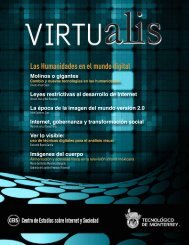P
terranova-network-culture
terranova-network-culture
- No tags were found...
Create successful ePaper yourself
Turn your PDF publications into a flip-book with our unique Google optimized e-Paper software.
Three Propositions on Informational Cultures 35a matter of catering for the youth or for migrants or for wealthyentrepreneurs, but also that of disintegrating, so to speak, suchyouth/migrants/entrepreneurs into their microstatistical composition– aggregating and disaggregating them on the basis of ever-changinginformational flows about their specific tastes and interests.Information transmission and processing techniques, asexemplified in the technical machine that Lev Manovitch considersto be the arch-model of the new media, the database, have helped todiscriminate and exploit the smallest differences in tastes, timetablesand orientations, bypassing altogether the self-evident, humanisticsubject, going from masses to populations of sub-individualizedunits of information. At the same time, this decomposition has notsimply affected the identical, but also the different. Gender, raceand sexuality, the mantra of the cultural politics of difference inthe 1980s and 1990s, have been reduced to recombinable elements,disassociated from their subjects and recomposed on a plane ofmodulation – a close sampling of the micromutations of the social,moving to the rhythm of market expansions and contractions.In this sense, the foregrounding of informational flows acrossthe socius also implies a crisis of representation (both linguisticand political). The statistical modulation of information is highlydisruptive in its relation to representation because it underminesthe perspectival and three-dimensional space which functions asa support for relations of mirrors and reflections as they engendersubjects, identities and selves. 44 In other words, the logic ofrepresentation presupposes a homogeneous space where differentsubjects can recognize each other when they are different and hencealso when they are identical. This applies both at the level of linguisticrepresentation (where I need to know what a man is in order to knowwhat a woman is); but also at the level of political representation (asdisplayed in the allocation of positions across a political spectrumthat is disposed from left to right as if facing an audience/publicsomehow always located at the centre). The analysis of the play ofdifferences in representation within the self–other dialectics, in fact,has always implied the support of a space where the other is observedas from across a space. It is this empty space organized by a threedimensionalperspective that gives support to the psychic dynamicsof identification, but also to the possibility of linguistic representationof the self and others as they are observed across such space. Thespace presupposed and engendered by an informational perspectiveexpresses a radical challenge to representation – and hence also to








